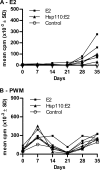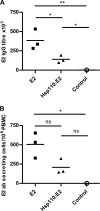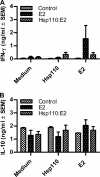Hsp110-mediated enhancement of CD4+ T cell responses to the envelope glycoprotein of members of the family Flaviviridae in vitro does not occur in vivo
- PMID: 21147937
- PMCID: PMC3067363
- DOI: 10.1128/CVI.00414-10
Hsp110-mediated enhancement of CD4+ T cell responses to the envelope glycoprotein of members of the family Flaviviridae in vitro does not occur in vivo
Abstract
The use of heat shock proteins (HSP) to enhance activation of the immune response to chaperoned antigen is being explored for immunotherapy. Hsp110 chaperones large protein substrates more effectively than Hsp70, offering the potential to use complex antigens containing multiple epitopes in HSP-based vaccines. In this study, we investigated the ability of recombinant bovine Hsp110 to chaperone E2 glycoprotein, the major envelope protein of bovine viral diarrhea virus (BVDV) and the dominant target of neutralizing antibodies. Hsp110 formed complexes with E2, as demonstrated by immunoprecipitation. When monocytes from BVDV-immunized cattle were stimulated with these complexes and incubated with autologous CD4(+) T cells, enhanced levels of proliferation were observed. To determine the ability of these complexes to improve immunogenicity in vivo, cattle were vaccinated with either Hsp110-E2 complex or E2 only, combined with Quil-A adjuvant. In contrast to the in vitro data, cellular and humoral responses to E2 were greater in the E2-only vaccination group, indicating that complex formation had actually reduced the immunogenicity of E2. This study highlights the need for further understanding of the means by which HSP complexes are endocytosed and processed in vivo to enable the design of successful vaccine strategies.
Figures





References
-
- Bendz, H., et al. 2007. Human heat shock protein 70 enhances tumor antigen presentation through complex formation and intracellular antigen delivery without innate immune signaling. J. Biol. Chem. 282:31688-31702. - PubMed
-
- Binder, R. J. 2006. Heat shock protein vaccines: from bench to bedside. Int. Rev. Immunol. 25:353-375. - PubMed
-
- Bogers, W. M. J. M., et al. 2004. A novel HIV-CCR5 receptor vaccine strategy in the control of mucosal SIV/HIV infection. AIDS 18:25-36. - PubMed
Publication types
MeSH terms
Substances
Grants and funding
LinkOut - more resources
Full Text Sources
Research Materials
Miscellaneous

